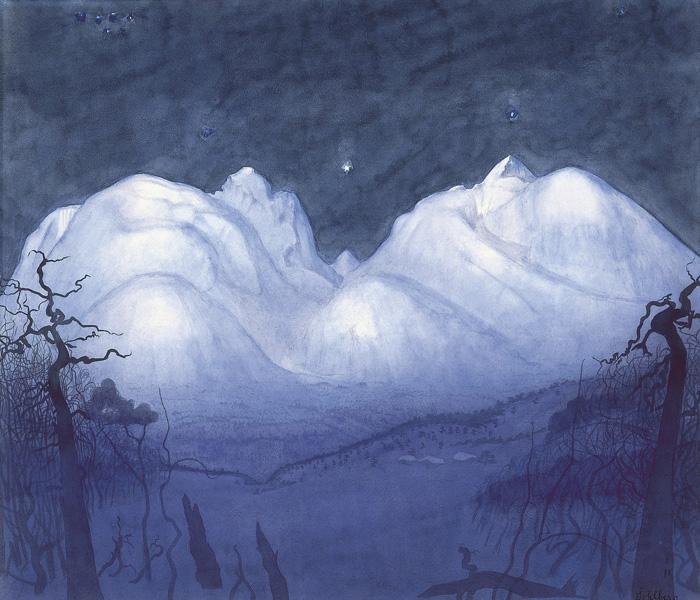
Other areas /
Google Ads
Mirror of NatureIf you want to know the social, political, philosophical, or religious history of any given country at any given time, visual art can prove helpful. |
SUBSCRIBE SEND AS EMAIL |

|
|
| 1 | |
|
Nordic Landscape Painting 1840-1910
If you want to know the social, political, philosophical, or religious history of any given country at any given time, visual art can prove helpful. More than just being pleasing to the eye, paintings tell us about a society, its social issues and dominating trends. This is true with the 110 noteworthy paintings by 65 Nordic artists, which make up Mirror of Nature: Nordic Landscape Painting 1840-1910. This is not to say that this traveling exhibition isn’t beautiful, but it also serves as a keyhole into what was happening on the art scene in the Scandinavian countries at that time, illuminating the Nordic contribution to this specific genre of art. Landscape painting assumed particular significance around the middle of the 19th century, when landscape subjects became symbols for an increasing sense of national identity. Scandinavians are known to enjoy an especially close relationship to nature. The National Galleries of Sweden, Norway, Denmark, and Finland organized the exhibition, and it took a team of eight curators to select the works by artists like Harald Sohlberg, Akseli Gallen-Kallela, Vilhelm Hammershøi, and Prince Eugen. “It’s an extraordinary exhibition,” says Patrick Noon, Curatorial Chair of Paintings and Modern Sculpture of the Minneapolis Institute of Arts. “It represents the crème-de-la-crème of the National collections in each Nordic country. You sense that everyone has done their utmost to put their best foot forward for an American audience with perhaps little knowledge of Scandinavian painting but great appreciation of it.” However uniquely Scandinavian and geographically cut-off from the rest of the continent, most of the artists were in touch with what was happening in the rest of Europe – the Realism, Symbolism, and Impressionism – and took these influences and translated them into Nordic colors and forms. Scandinavian landscape painting, explained Noon, differs from French and British in its presentation of light, nature, and terrain. “There’s a strongly felt romanticism, especially in the earlier paintings. Actually the exhibition is divided into five sections. The first one is Nordic Sublime, which features the Romanticism of the 1840’s. Then Close to Nature, showing Realism, with portrayals of less heroic landscapes. Open Air features open-air paintings: At this point in time, artists didn’t just sketch outside, they’d bring out their easels and paints and actually finish the entire painting outdoors. Evocative Landscapes shows Symbolism, with the idea of an emotional landscape, highly personalized; and, finally there’s Landscapes of the Mind, featuring what we call true landscapes of the soul – these paintings show landscapes that are entirely personal, almost abstract, and clearly moving toward Expressionism. Here we have August Strindberg and Edvard Munch, for instance.” The Minneapolis Institute of Arts represents the only American venue for the exhibition - a clever move, according to Noon. “We have the right demographics for an exhibition like this here in Minneapolis, but it benefits us in other ways, too. As a museum we’re strong on 19th century landscape in general, so this is great – we’re showing what happens in landscape painting at another place in the world at the same period. Also this exhibition transcends painting, it’ll form the centerpiece of our Nordic Summer celebrations. Mirror of Nature is going to be a big event; all consul generals have come here asking, ‘What can we do to make this great?’ It’s an excellent opportunity for the Nordic countries to promote themselves. And it is, of course, very beautiful.” Does Noon have any personal favorites? “Oh, that’s hard to say. It’s [unlikely] to see many of these artists in the U.S., such as the Finnish painter Akseli Gallen-Kalela. I also like Norwegian Johan Christian Dahl. There’s a spoof on an open-air painting by Swede Carl Larsson where he is sitting in the snow.” Mirror of Nature: Nordic landscape Painting 1840-1910, which opened at the Ateneum Art Museum in Helsinki last spring and has toured Stockholm’s and Oslo’s National Museums, will open at the Minneapolis Institute of Arts on June 24 and run through September 2, when it leaves for Statens Museum for Kunst in Copenhagen. www.artsmia.org One of Finland’s foremost artists, Akseli Gallen-Kallela, who lived in the United States between 1924 and 1926, was also exhibited at Hancock, Michigan-based Finlandia University this winter. The exhibition at Finlandia was mostly comprised of 39 of Gallen-Kallela’s illustrations for the “Kalevala,” which were presented to the University by the artist in 1924. Mirror of Nature will introduce you to the pictorial art of the artist, but in his native Finland he is predominantly known for his fascination with, and illustrations of, the Finnish national epic, the Kalevala. |
Other articles on Art / A Look at Three-Dimensional Scandinavian Art Bedroom politics a century ago When Claude Monet Did Norway Scandinavian Art in New York Cirkus Cirkör gets under your skin East Meets West Queens kids visit Ribe, Denmark Scandinavian art in New York Immigrant Chefs in America Scandinavian at the International Contemporary Furniture Fair in New York
|
800 827 9333 © Copyright Nordic Reach 2008